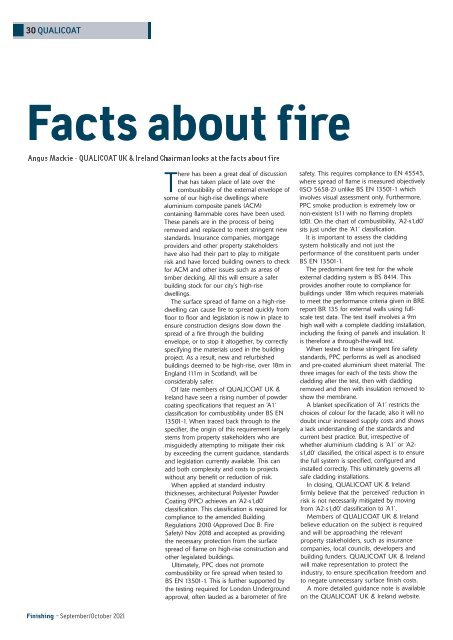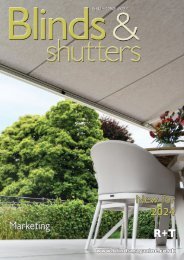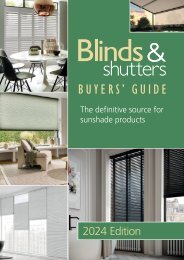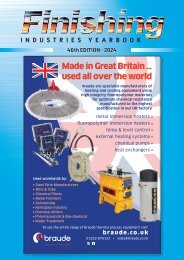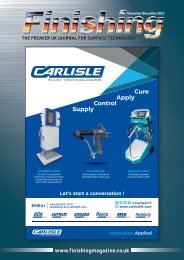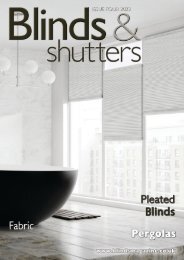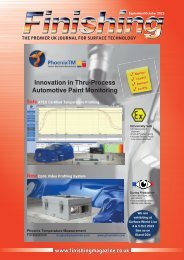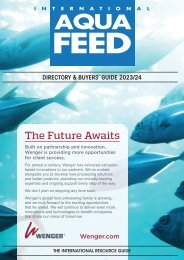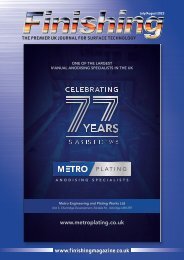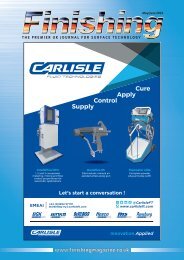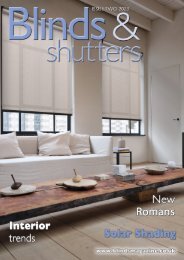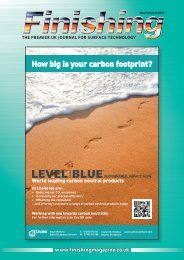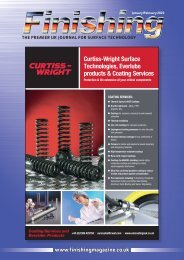You also want an ePaper? Increase the reach of your titles
YUMPU automatically turns print PDFs into web optimized ePapers that Google loves.
30 QUALICOAT<br />
Facts about fire<br />
There has been a great deal of discussion<br />
that has taken place of late over the<br />
combustibility of the external envelope of<br />
some of our high-rise dwellings where<br />
aluminium composite panels (ACM)<br />
containing flammable cores have been used.<br />
These panels are in the process of being<br />
removed and replaced to meet stringent new<br />
standards. Insurance companies, mortgage<br />
providers and other property stakeholders<br />
have also had their part to play to mitigate<br />
risk and have forced building owners to check<br />
for ACM and other issues such as areas of<br />
timber decking. All this will ensure a safer<br />
building stock for our city’s high-rise<br />
dwellings.<br />
The surface spread of flame on a high-rise<br />
dwelling can cause fire to spread quickly from<br />
floor to floor and legislation is now in place to<br />
ensure construction designs slow down the<br />
spread of a fire through the building<br />
envelope, or to stop it altogether, by correctly<br />
specifying the materials used in the building<br />
project. As a result, new and refurbished<br />
buildings deemed to be high-rise, over 18m in<br />
England (11m in Scotland), will be<br />
considerably safer.<br />
Of late members of QUALICOAT UK &<br />
Ireland have seen a rising number of powder<br />
coating specifications that request an ‘A1’<br />
classification for combustibility under BS EN<br />
13501-1. When traced back through to the<br />
specifier, the origin of this requirement largely<br />
stems from property stakeholders who are<br />
misguidedly attempting to mitigate their risk<br />
by exceeding the current guidance, standards<br />
and legislation currently available. This can<br />
add both complexity and costs to projects<br />
without any benefit or reduction of risk.<br />
When applied at standard industry<br />
thicknesses, architectural Polyester Powder<br />
Coating (PPC) achieves an ‘A2-s1,d0’<br />
classification. This classification is required for<br />
compliance to the amended Building<br />
Regulations 2010 (Approved Doc B: Fire<br />
Safety) Nov 2018 and accepted as providing<br />
the necessary protection from the surface<br />
spread of flame on high-rise construction and<br />
other legislated buildings.<br />
Ultimately, PPC does not promote<br />
combustibility or fire spread when tested to<br />
BS EN 13501-1. This is further supported by<br />
the testing required for London Underground<br />
approval, often lauded as a barometer of fire<br />
safety. This requires compliance to EN 45545,<br />
where spread of flame is measured objectively<br />
(ISO 5658-2) unlike BS EN 13501-1 which<br />
involves visual assessment only. Furthermore,<br />
PPC smoke production is extremely low or<br />
non-existent (s1) with no flaming droplets<br />
(d0). On the chart of combustibility, ‘A2-s1,d0’<br />
sits just under the ‘A1’ classification.<br />
It is important to assess the cladding<br />
system holistically and not just the<br />
performance of the constituent parts under<br />
BS EN 13501-1.<br />
The predominant fire test for the whole<br />
external cladding system is BS 8414. This<br />
provides another route to compliance for<br />
buildings under 18m which requires materials<br />
to meet the performance criteria given in BRE<br />
report BR 135 for external walls using fullscale<br />
test data. The test itself involves a 9m<br />
high wall with a complete cladding installation,<br />
including the fixing of panels and insulation. It<br />
is therefore a through-the-wall test.<br />
When tested to these stringent fire safety<br />
standards, PPC performs as well as anodised<br />
and pre-coated aluminium sheet material. The<br />
three images for each of the tests show the<br />
cladding after the test, then with cladding<br />
removed and then with insulation removed to<br />
show the membrane.<br />
A blanket specification of ‘A1’ restricts the<br />
choices of colour for the facade, also it will no<br />
doubt incur increased supply costs and shows<br />
a lack understanding of the standards and<br />
current best practice. But, irrespective of<br />
whether aluminium cladding is ‘A1’ or ‘A2-<br />
s1,d0’ classified, the critical aspect is to ensure<br />
the full system is specified, configured and<br />
installed correctly. This ultimately governs all<br />
safe cladding installations.<br />
In closing, QUALICOAT UK & Ireland<br />
firmly believe that the ‘perceived’ reduction in<br />
risk is not necessarily mitigated by moving<br />
from ‘A2-s1,d0’ classification to ‘A1’.<br />
Members of QUALICOAT UK & Ireland<br />
believe education on the subject is required<br />
and will be approaching the relevant<br />
property stakeholders, such as insurance<br />
companies, local councils, developers and<br />
building funders. QUALICOAT UK & Ireland<br />
will make representation to protect the<br />
industry, to ensure specification freedom and<br />
to negate unnecessary surface finish costs.<br />
A more detailed guidance note is available<br />
on the QUALICOAT UK & Ireland website.<br />
<strong>Finishing</strong> - <strong>September</strong>/<strong>October</strong> <strong>2021</strong>


